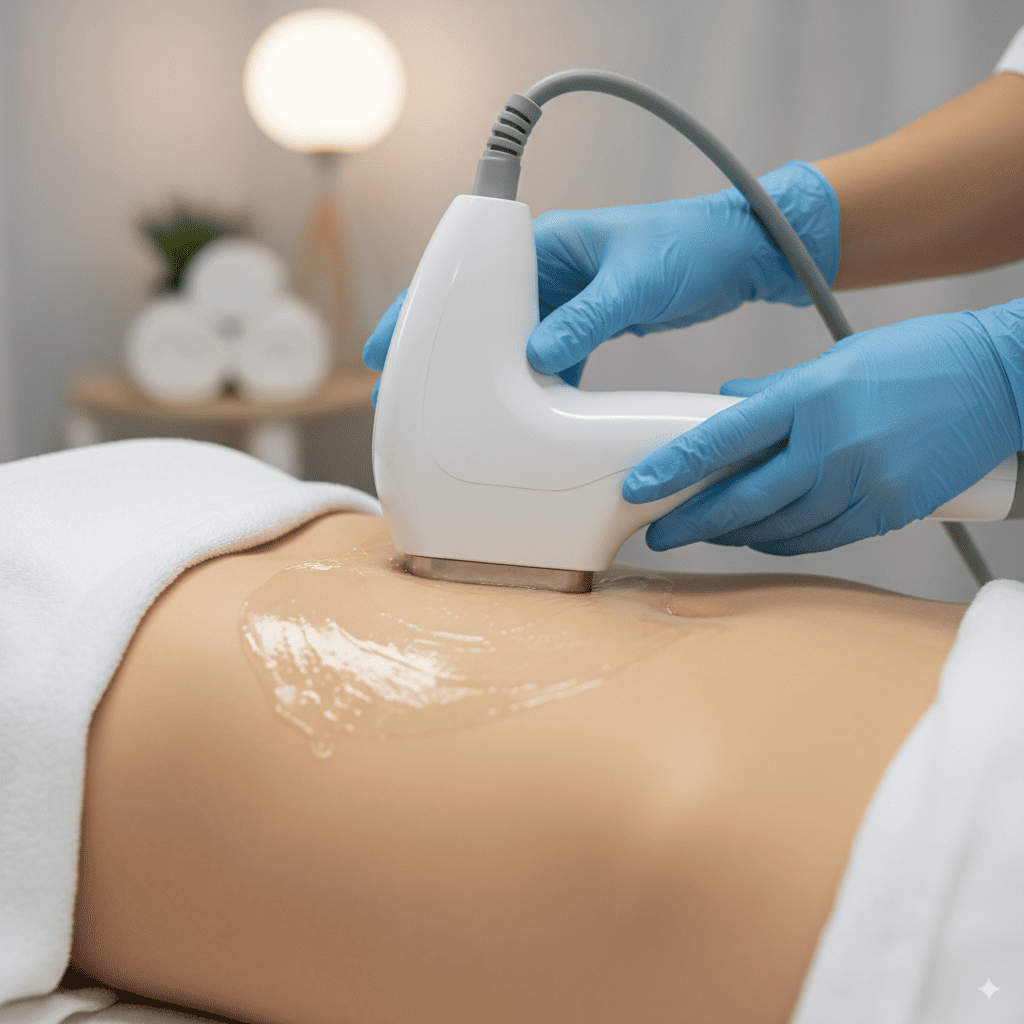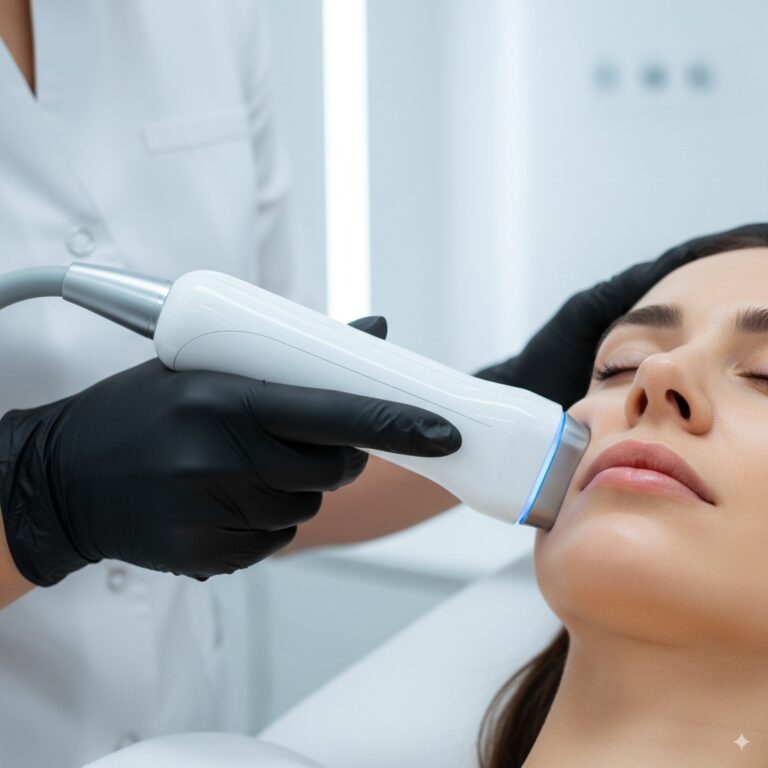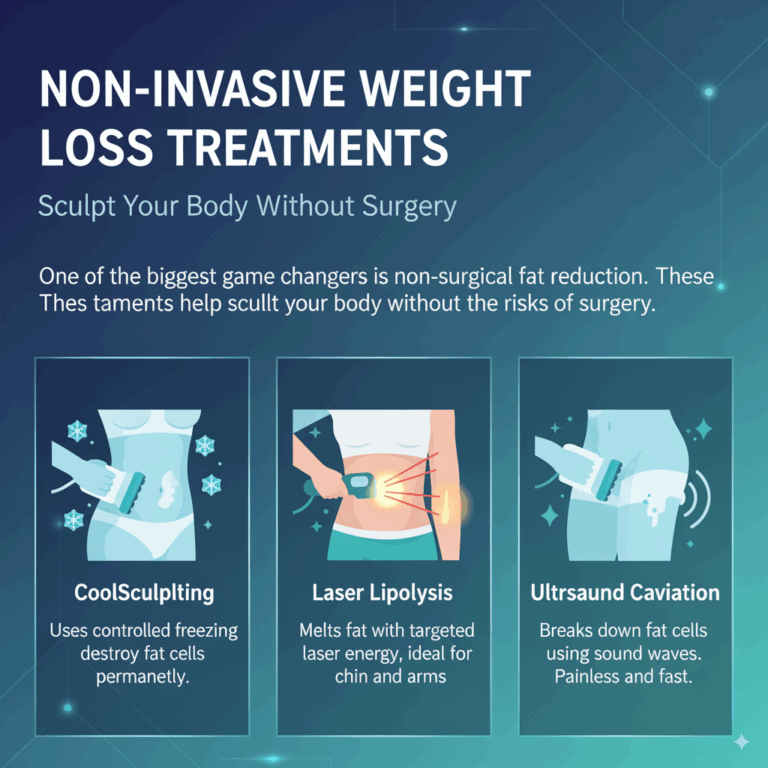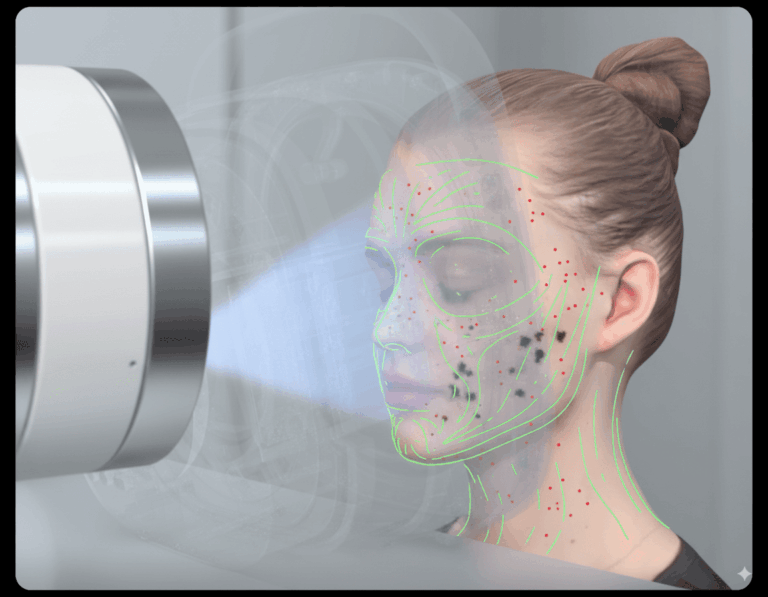O guia definitivo para cavitação RF de 40K: a ciência por trás da modelagem corporal e facial sem esforço
Have you ever stared in the mirror, frustrated by those stubborn pockets of fat that just won’t budge, no matter how much you diet or exercise? That little pouch on your lower abdomen, the persistent love handles, or the slight jiggle under your arms. It’s a universal struggle. For decades, the only real solution was invasive surgery like liposuction—a daunting prospect involving anesthesia, scalpels, and significant downtime. But what if I told you that science has delivered a way to literally melt away fat and tighten your skin, without a single incision?
Welcome to the world of 40K Cavitation RF. It sounds like something out of a science fiction movie, but this technology is one of the most revolutionary advancements in the non-invasive aesthetics industry. It’s a dual-action treatment that offers a one-two punch against unwanted fat and loose skin, helping you sculpt the body and face you’ve been working towards. But how does it realmente work? It’s not magic; it’s fascinating, deep science. Let’s pull back the curtain and explore the incredible physics and biology that make this treatment so spectacularly effective.
Beyond the Hype: What Exactly Is This Breakthrough Technology?
At its core, 40K Cavitation RF is a combination therapy. It uses two distinct technologies in tandem to achieve comprehensive results that neither could accomplish alone. Think of it like a highly specialized construction crew for your body. The first part of the crew, Ultrasonic Cavitation, is the demolition team. It’s designed to specifically target and destroy fat cells. The second part, Radiofrequency (RF), is the renovation and reinforcement team. It comes in to tighten, smooth, and rebuild the skin’s underlying structure.
This isn’t just a surface-level treatment that temporarily squeezes water out of your cells. We’re talking about a process that fundamentally alters fat cells and stimulates your body’s natural regenerative processes. It’s a way to contour specific areas, reduce the appearance of cellulite, and rejuvenate the skin on both your body and face. The beauty lies in its precision and non-invasive nature—it works in harmony with your body, not against it.
Decoding the “40K”: The Critical Importance of Frequency
Before we dive into the two pillars of the treatment, let’s address the “40K” in the name. What does it mean? The “40K” stands for 40,000 Hertz (or 40 kHz). This isn’t just a random number; it’s the specific frequency of the ultrasonic waves used in the cavitation part of the treatment. And this frequency is the secret sauce.
Imagine a singer who can shatter a crystal glass with their voice. They must hit a precise note—the glass’s resonant frequency—to cause it to vibrate so intensely that it shatters. Frequencies below or above that specific note will have little effect. The same principle applies here. Scientific research has shown that a frequency of around 40 kHz is the optimal “resonant frequency” for human adipose tissue (fat cells). This frequency is low enough to penetrate deep into the subcutaneous fat layer where stubborn fat resides, yet it’s perfectly calibrated to affect only the fat cells, leaving surrounding tissues like skin, nerves, and blood vessels completely unharmed. It’s a targeted strike at a microscopic level, and it’s this precision that makes the technology both incredibly effective and remarkably safe.
Pillar One: The Astonishing Physics of Ultrasonic Cavitation
Now, let’s get to the demolition team. How can sound, something we associate with hearing, actually destroy fat? The science is called “cavitation,” and it’s a stunning example of physics at work within our bodies.
How Sound Waves Magically Liquefy Fat
When the 40 kHz ultrasonic waves are directed at a targeted area of fat, they travel through the skin and into the fat layer. These sound waves create a powerful vibration and pressure changes within the interstitial fluid—the fluid that surrounds all your cells. This is where the magic, or rather the science, begins.
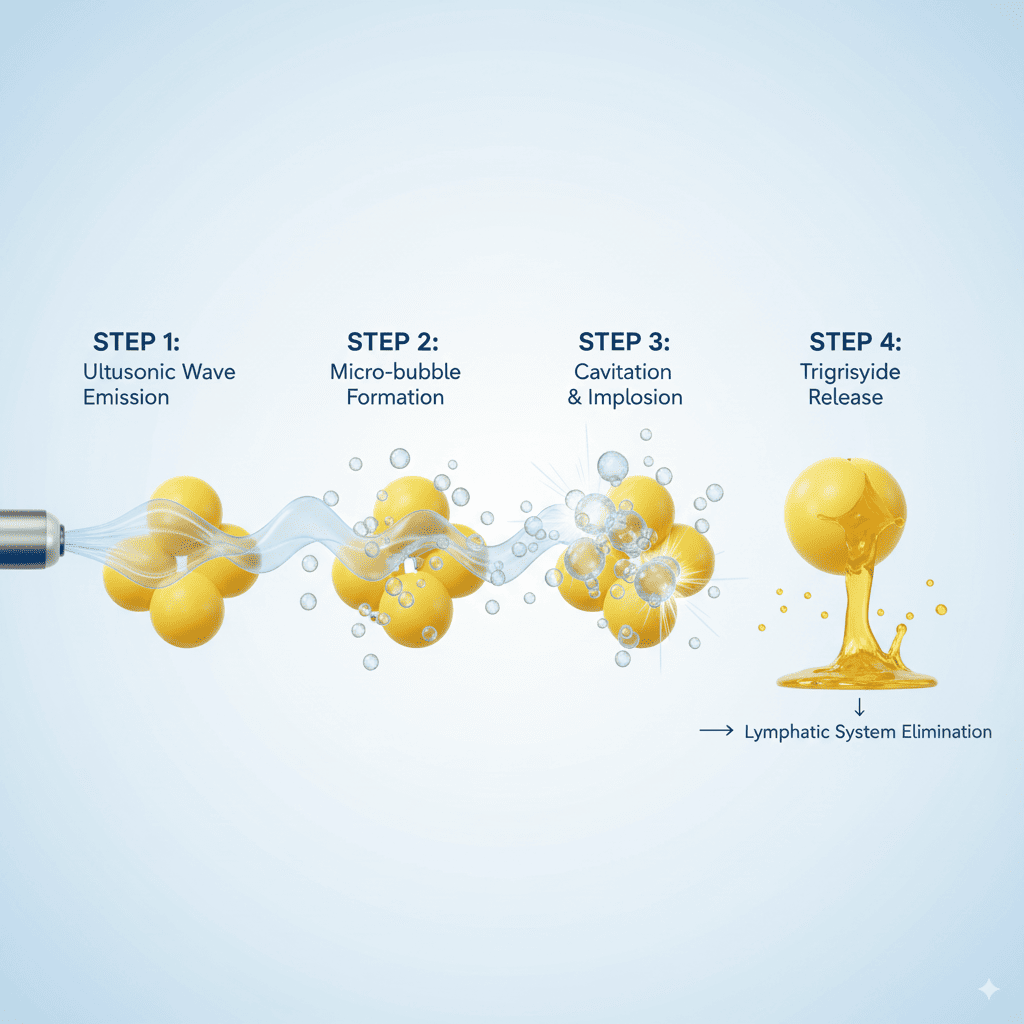
The rapid and continuous pressure changes cause microscopic bubbles to form within this fluid. This phenomenon is cavitation. Think of shaking a bottle of soda—you’re changing the pressure and creating countless bubbles. The 40K ultrasound device does this on a micro-level, creating thousands of these tiny vapor-filled bubbles right next to the fat cells.
The Bubble Effect: A Microscopic Tsunami for Fat Cells
These newly formed microbubbles are not stable. Fueled by the energy of the 40 kHz sound waves, they oscillate and grow larger. They expand and contract rapidly until they reach a critical size where they can no longer sustain their own structure. At this point, they violently implode.
This implosion creates a powerful shockwave, a tiny but potent tsunami, right in the fatty tissue. This shockwave is strong enough to rupture the cell membrane (the wall) of the nearby adipocytes, or fat cells. The fat cells, which are essentially tiny bags holding triglycerides (stored fat), are broken apart. Their contents—triglycerides, fatty acids, and glycerol—are released into the interstitial fluid. The fat cell itself is permanently destroyed. It doesn’t shrink; it ceases to exist.
The Aftermath: Where Does the Fat Go?
This is the most common and important question people ask. You’ve just liquefied fat cells; where does all that liquid fat go? Does it just sit there? Absolutely not. Your body has an incredibly efficient disposal and recycling system: the lymphatic system and the liver.
Once the triglycerides are released, they are broken down into glycerol and free fatty acids. The water-soluble glycerol is absorbed by the circulatory system and used as an energy source. The insoluble free fatty acids are transported via the lymphatic system to the liver. The liver then processes these fatty acids just as it would process fat from the food you eat. It either metabolizes them for energy or excretes them from the body as waste.
This is why aftercare is so crucial. Drinking plenty of water is essential to help your lymphatic system flush everything out efficiently. A bit of light exercise post-treatment can also help your body burn the newly released fatty acids as fuel. Your body does the heavy lifting; the cavitation treatment is simply the catalyst.
Pillar Two: The Rejuvenating Power of Radiofrequency (RF)
Destroying the fat cells is only half the battle. Imagine deflating a balloon. The air is gone, but you’re left with a loose, wrinkled shell. Similarly, after removing fat from an area, the overlying skin can sometimes be left looking lax or saggy. This is where the renovation team, Radiofrequency (RF), makes its grand entrance.
The “Shrink Wrap” Effect: How RF Tightens and Tones
Radiofrequency technology works by delivering controlled energy into the deeper layers of the skin, specifically the dermis and subcutaneous layers. Unlike lasers, which work on the surface, RF energy is a form of electrical current that generates heat when it encounters the resistance of the tissue.
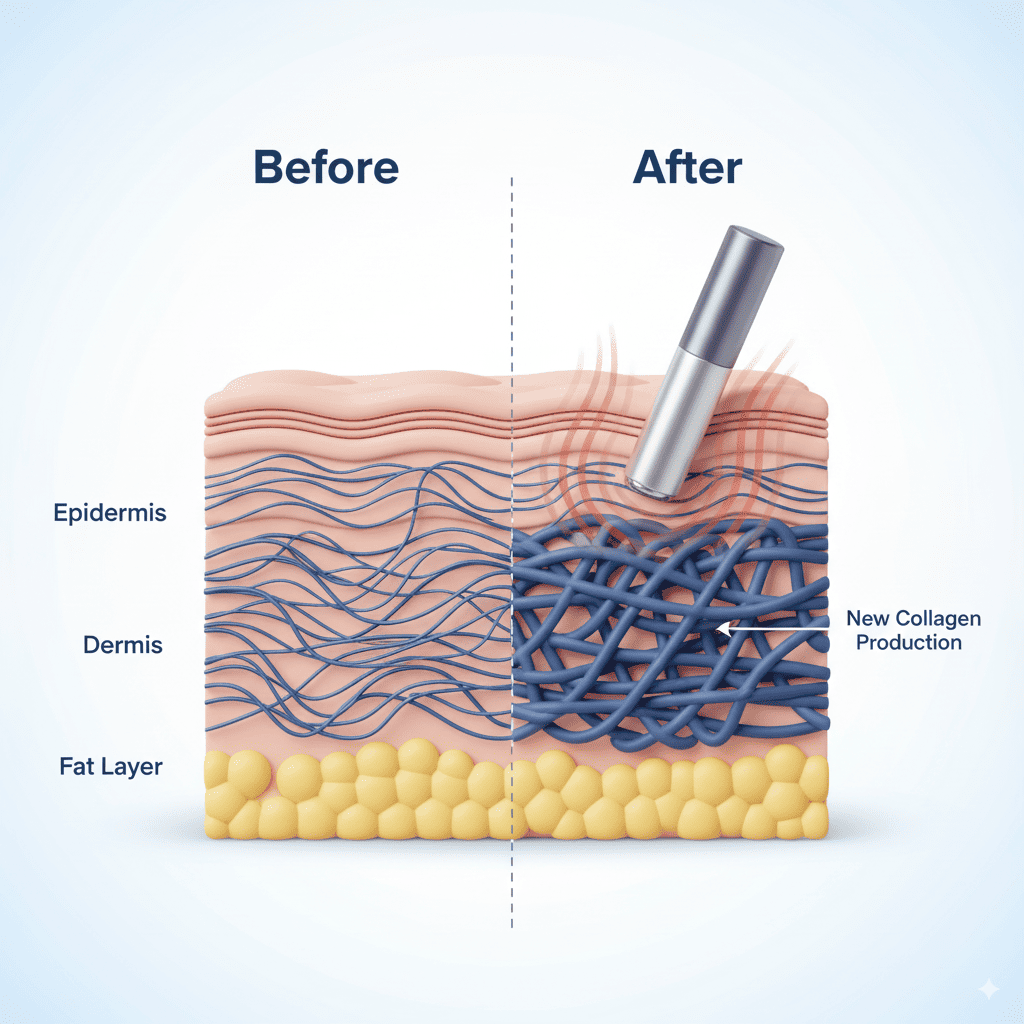
This controlled heating has two immediate and profound effects. First, it causes the existing collagen fibers in your skin to contract and tighten. Collagen is the main structural protein that gives your skin its firmness and elasticity. You can think of these fibers like tiny springs. Over time, they stretch out. The heat from the RF treatment causes them to instantly shrink back, providing an immediate tightening and lifting effect. It’s like a “shrink wrap” for your skin, making it look firmer right away.
Igniting the Collagen Factory: The Long-Term Benefits
The immediate tightening is great, but the true brilliance of RF lies in its long-term benefits. The controlled thermal “injury” to the dermis acts as a signal to your body’s natural healing response. Your body thinks, “There’s been some heat damage here; we need to repair it!” This kicks your fibroblasts—the cells responsible for producing collagen—into high gear.
Over the following weeks and months, these supercharged fibroblasts produce new, strong, and healthy collagen and elastin fibers. This process is known as neocollagenesis. The result is a fundamental rebuilding of your skin’s support structure from the inside out. Your skin doesn’t just look tighter; it is tighter, smoother, and more youthful. This is why RF is so effective at reducing the appearance of wrinkles, fine lines, and cellulite, and for providing that final, sculpted finish to a body contouring treatment.
The Synergistic Masterstroke: Why Cavitation and RF Are the Perfect Pair
Now you can see why these two technologies are a match made in aesthetic heaven. They address different aspects of the same problem, working together for a result that is greater than the sum of their parts.
- Cavitation handles the bulk reduction. It debulks the fatty area, permanently destroying the fat cells that create the bulge.
- RF handles the refinement and finishing. It tightens the skin that may have become lax after the fat loss, smooths out dimples and cellulite, and improves overall skin quality and texture.
Using cavitation alone might leave you with looser skin. Using RF alone on a bulky area would tighten the skin but wouldn’t get rid of the underlying volume. By combining them in a single treatment session, you get the fat reduction e the skin tightening simultaneously. It’s a comprehensive approach that ensures a smooth, toned, and naturally contoured final result.
A Glimpse into the Treatment Room: What to Expect During Your Session
So, what does a 40K Cavitation RF session actually feel like? It’s surprisingly comfortable and relaxing. First, a conductive gel is applied to the treatment area. This gel helps the treatment heads glide smoothly over the skin and ensures the ultrasonic and radiofrequency waves are delivered efficiently.

The practitioner will then begin with the cavitation portion. As the device head moves over your skin, you might hear a high-pitched ringing or buzzing sound in your ears. This is completely normal and is caused by the sound waves vibrating through your body’s fluids to your inner ear. You won’t feel any pain, perhaps just a very mild warmth.
Next comes the RF portion. The device head will be switched, and as it moves over the same area, you’ll feel a pleasant, deep warming sensation. Many clients compare it to a hot stone massage. The practitioner monitors the skin temperature to ensure it reaches the optimal therapeutic level for collagen stimulation without ever becoming uncomfortable. A typical session for one area (like the abdomen) lasts between 40 and 60 minutes, and there is absolutely no downtime. You can get right back to your day immediately after.
Are You the Ideal Candidate for This Sculpting Science?
While 40K Cavitation RF is a powerful tool, it’s important to have realistic expectations. It is not a weight-loss treatment for obesity. Instead, it’s a body contouring e shaping solution. The ideal candidate is someone who is:
- Generally healthy and within 15-20 pounds of their ideal weight.
- Struggling with localized, stubborn pockets of fat that are resistant to diet and exercise.
- Looking to improve skin laxity or the appearance of cellulite.
- Seeking a non-invasive alternative to surgery with no downtime.
It’s perfect for areas like the abdomen, love handles, thighs (“saddlebags”), upper arms, back fat, and even for toning the jawline and neck. A consultation with a qualified provider is the best way to determine if this treatment will help you achieve your specific goals.
Conclusion: Embracing the Future of Non-Invasive Aesthetics
The science behind 40K Cavitation RF is a testament to how far we’ve come in understanding the body’s intricate systems. We’re no longer just dreaming of non-surgical solutions; we are living in an era where they are a reality. By harnessing the precise power of ultrasonic frequencies to selectively destroy fat cells and leveraging the regenerative capabilities of radiofrequency energy to rebuild our skin’s foundation, we can achieve remarkable changes.

This isn’t about chasing an unrealistic ideal of perfection. It’s about empowerment. It’s about having a scientifically-backed tool to finally address those areas that have frustrated you, helping you feel more confident and comfortable in your own skin. The future of aesthetics isn’t about dramatic, invasive changes; it’s about smart, subtle, and scientific sculpting. And with technologies like 40K Cavitation RF, that future is already here.
Perguntas Mais Frequentes (FAQs)
1. Is the 40K Cavitation RF treatment painful? Not at all. The cavitation portion is essentially painless; the only sensation is a high-frequency sound some people can hear. The radiofrequency portion feels like a warm, relaxing massage. There are no needles, no incisions, and no anesthesia required.
2. How many sessions will I need to see results? Most people begin to see and feel a difference after just 1-3 sessions. However, for optimal and lasting results, a course of 6-12 sessions, spaced about a week apart, is typically recommended. The exact number depends on your individual body composition, the area being treated, and your aesthetic goals.
3. Os resultados são permanentes? Os resultados podem ser permanentes, com uma pequena ressalva. As células de gordura que são destruídas durante o processo de cavitação desaparecem para sempre e não se regeneram. No entanto, se você ganhar uma quantidade significativa de peso após os tratamentos, as células de gordura restantes em seu corpo ainda podem se expandir. Os resultados de endurecimento da pele da RF podem durar anos, mas o processo natural de envelhecimento continuará. Uma dieta saudável e exercícios regulares são fundamentais para manter seus resultados esculpidos a longo prazo.
4. Existem efeitos colaterais ou tempo de inatividade? Esta é uma das maiores vantagens do tratamento. Não há tempo de inatividade. Você pode retornar às suas atividades diárias, incluindo trabalho e exercícios, imediatamente. Algumas pessoas podem sentir vermelhidão leve, leve inchaço ou sensibilidade temporária na área tratada, mas isso geralmente desaparece em algumas horas. O aumento da sede também é comum quando seu corpo inicia o processo de rubor.
5. Este tratamento pode ser usado no rosto e no corpo? Sim, absolutamente! Embora a cavitação seja normalmente reservada para o corpo, o componente de radiofrequência (RF) é um tratamento padrão-ouro para o rejuvenescimento facial. É fantástico para apertar a pele flácida ao redor da papada e do pescoço, reduzindo a aparência de linhas finas e rugas e promovendo uma tez mais jovem e levantada, estimulando a produção de colágeno tão importante.

